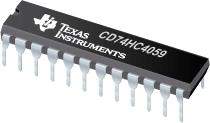●The HC4059 are high-speed silicon-gate devices that are pin-compatible with the CD4059A devices of the CD4000B series. These devices are divide-by-N down-counters that can be programmed to divide an input frequency by any number "N" from 3 to 15,999. The output signal is a pulse one clock cycle wide occurring at a rate equal to the input frequency divide by N. The down-counter is preset by means of 16 jam inputs.
●The three Mode-Select Inputs Ka,Kb and Kc determine the modulus ("divide-by" number) of the first and last counting sections in accordance with the truth table. Every time the first (fastest) counting section goes through one cycle, it reduces by 1 the number that has been preset (jammed) into the three decades of the intermediate counting section an the last counting section, which consists of flip-flops that are not needed for opening the first counting section. For example, in the 10) counters presettable by means of Jam Inputs J5 through J16.
●The Mode-Select Inputs permit frequency-synthesizer channel separations of 10, 12.5, 20, 25 or 50 parts. These inputs set the maximum value of N at 9999 (when the first counting section divides by 5 or 10) or 15,999 (when the first counting section divides by 8, 4, or 2).
●The three decades of the intermediate counter can be preset to a binary 15 instead of a binary 9, while their place values are still 1, 10, and 100, multiplied by the number of the 8 mode, the number from which counting down begins can be preset to:
● 3rd Decade 1500
● 2nd Decade 150
● 1st Decade 15
● Last Counting Section 1000
●The total of these numbers (2665) times 8 equals 12,320. The first counting section can be preset to 7. Therefore, 21,327 is the maximum possible count in the 8 mode.
●The highest count of the various modes is shown in the Extended Counter Range column. Control inputs Kb and Kc can be used to initiate and lock the counter in the "master preset" state. In this condition the flip-flops in the counter are preset in accordance with the jam inputs and the counter remains in that state as long as Kb and Kc both remain low. The counter begins to count down from the preset state when a counting mode other than the master preset mode is selected.
●The counter should always be put in the master preset mode before the 5 mode is selected. Whenever the master preset mode is used, control signals Kb = "low" and Kc = "low" must be applied for at least 3 full clock pulses.
●After Preset Mode inputs have been changed to one of the 8 mode). If the Master Preset mode is started two clock cycles or less before an output pulse, the output pulse will appear at the time due. If the Master Preset Mode is not used, the counter jumps back to the "Jam" count when the output pulse appears.
●A "high" on the Latch Enable input will cause the counter output to remain high once an output pulse occurs, and to remain in the high state until the latch input returns to "low". If the Latch Enable is "low", the output pulse will remain high for only one cycle of the clock-input signal.
● Synchronous Programmable N Counter N = 3 to 9999 or 15999
● Presettable Down-Counter
● Fully Static Operation
● Mode-Select Control of Initial Decade Counting Function (10, 8, 5, 4, 2)
● Master Preset Initialization
● Latchable N Output
● Fanout (Over Temperature Range)
● Standard Outputs . . . . . . . . . . . . . . . 10 LSTTL Loads
● Bus Driver Outputs . . . . . . . . . . . . . 15 LSTTL Loads
● Wide Operating Temperature Range . . . -55°C to 125°C
● Balanced Propagation Delay and Transition Times
● Significant Power Reduction Compared to LSTTL Logic ICs
● HC Types
● 2V to 6V Operation
● High Noise Immunity: NIL = 30%, NIH = 30% of VCC at VCC = 5V
● Applications
● Communications Digital Frequency Synthesizers;
●VHF, UHF, FM, AM, etc.
● Fixed or Programmable Frequency Division
● "Time Out" Timer for Consumer-Application Industrial Controls



